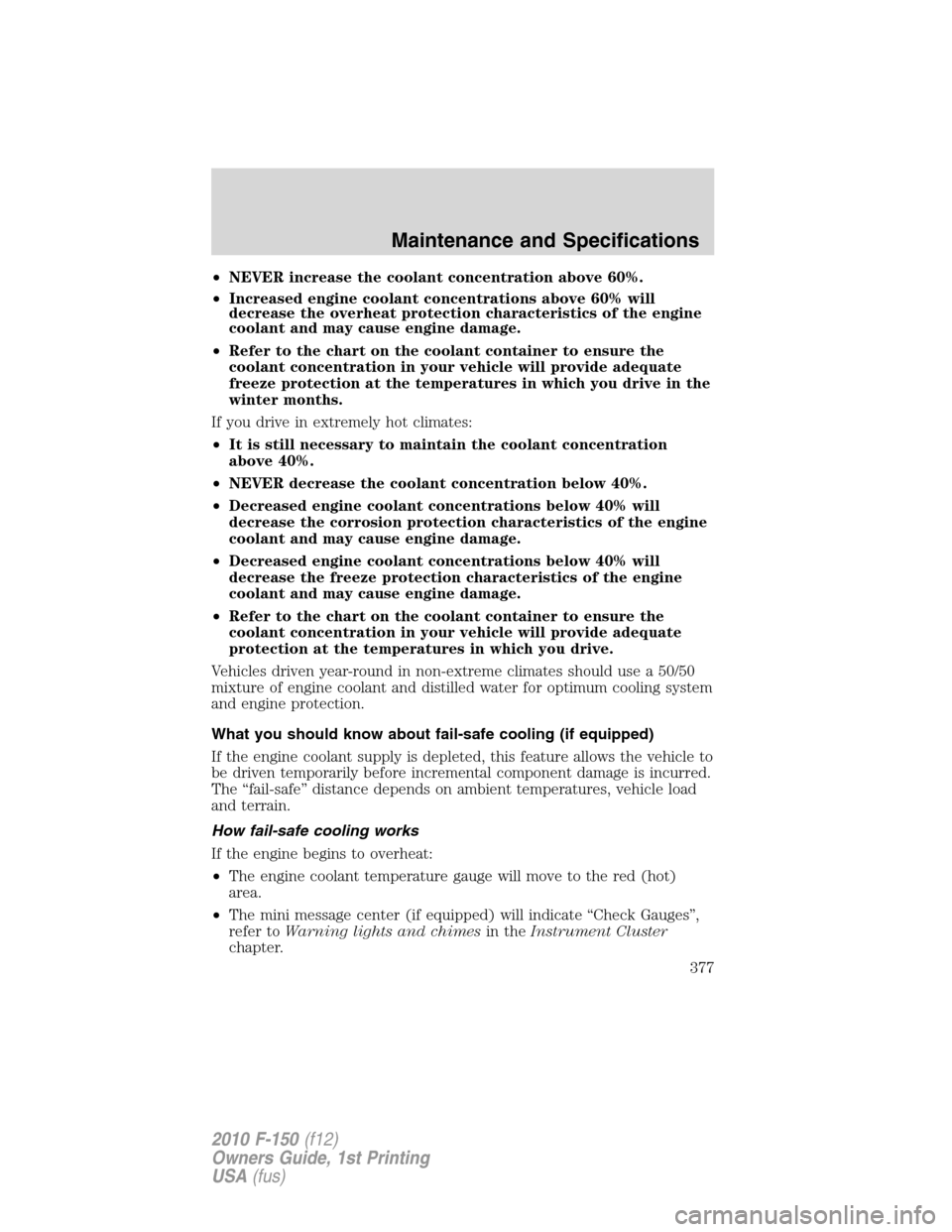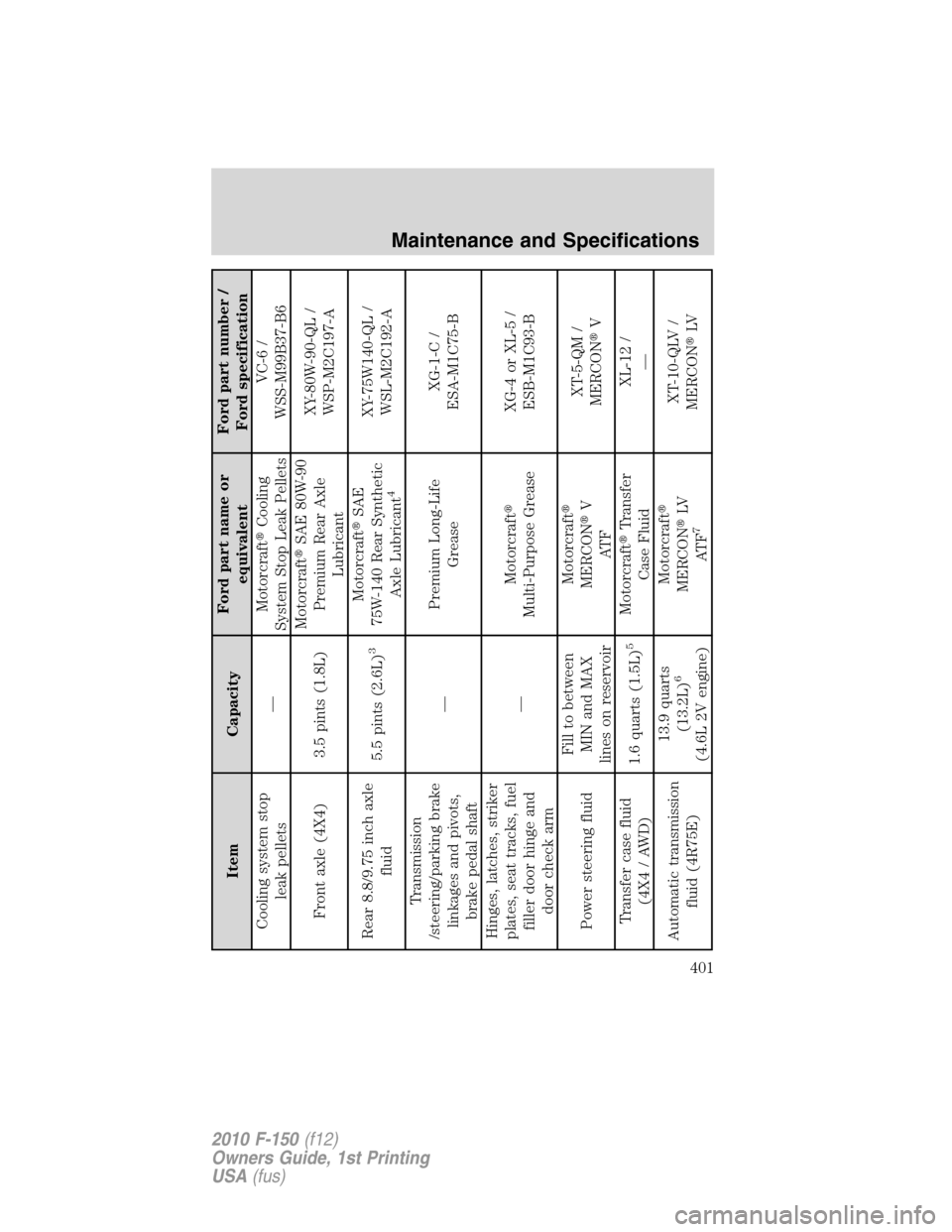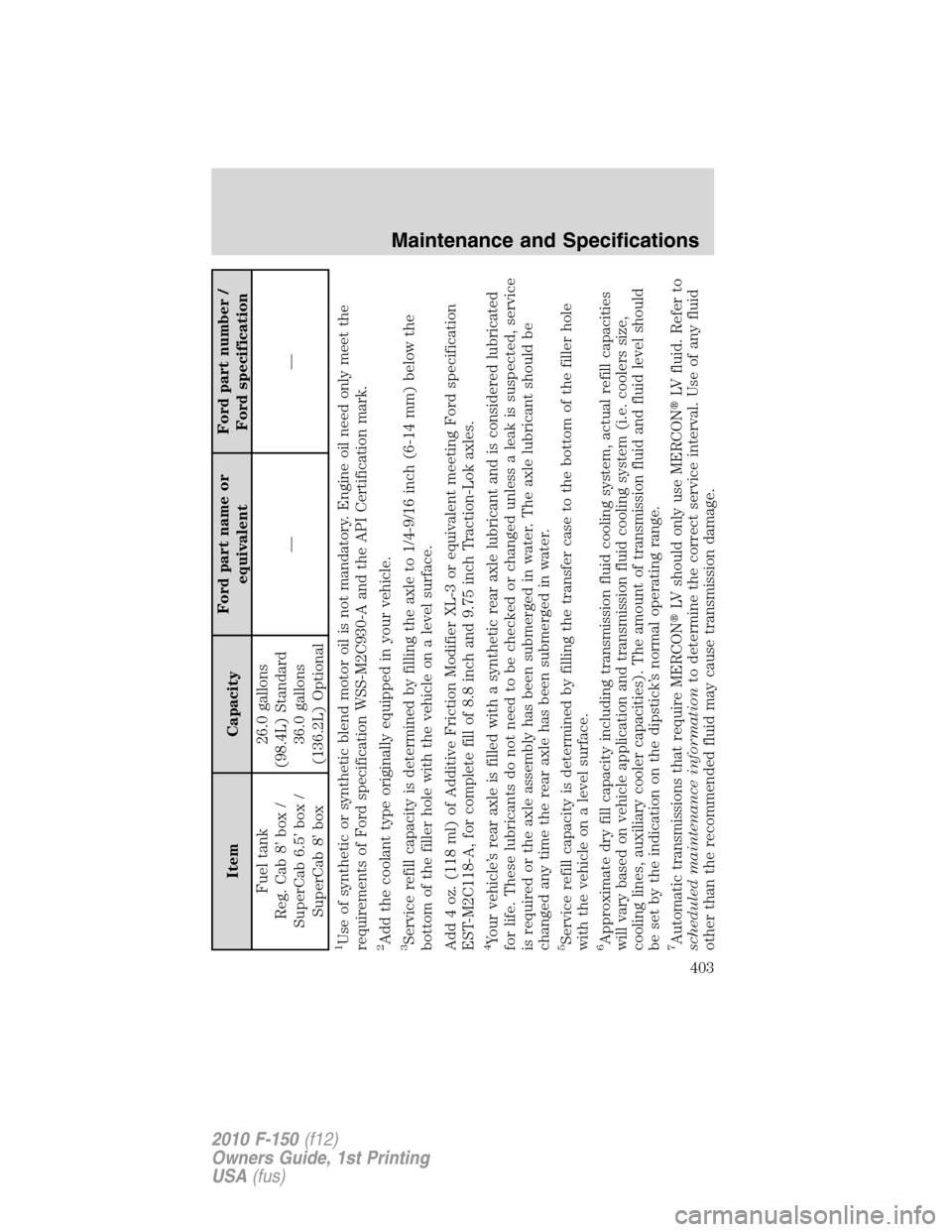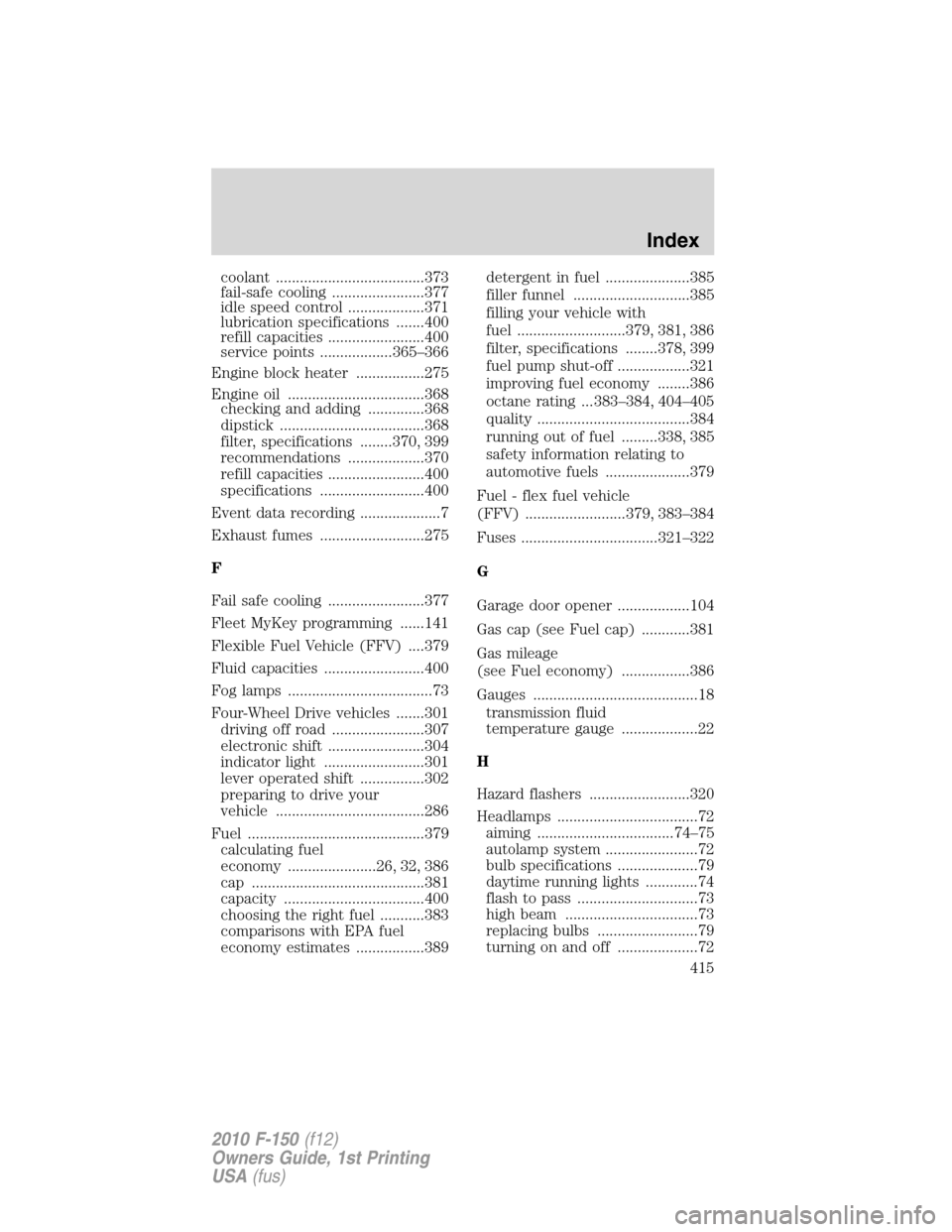Page 377 of 419

•NEVER increase the coolant concentration above 60%.
•Increased engine coolant concentrations above 60% will
decrease the overheat protection characteristics of the engine
coolant and may cause engine damage.
•Refer to the chart on the coolant container to ensure the
coolant concentration in your vehicle will provide adequate
freeze protection at the temperatures in which you drive in the
winter months.
If you drive in extremely hot climates:
•It is still necessary to maintain the coolant concentration
above 40%.
•NEVER decrease the coolant concentration below 40%.
•Decreased engine coolant concentrations below 40% will
decrease the corrosion protection characteristics of the engine
coolant and may cause engine damage.
•Decreased engine coolant concentrations below 40% will
decrease the freeze protection characteristics of the engine
coolant and may cause engine damage.
•Refer to the chart on the coolant container to ensure the
coolant concentration in your vehicle will provide adequate
protection at the temperatures in which you drive.
Vehicles driven year-round in non-extreme climates should use a 50/50
mixture of engine coolant and distilled water for optimum cooling system
and engine protection.
What you should know about fail-safe cooling (if equipped)
If the engine coolant supply is depleted, this feature allows the vehicle to
be driven temporarily before incremental component damage is incurred.
The “fail-safe” distance depends on ambient temperatures, vehicle load
and terrain.
How fail-safe cooling works
If the engine begins to overheat:
•The engine coolant temperature gauge will move to the red (hot)
area.
•The mini message center (if equipped) will indicate “Check Gauges”,
refer toWarning lights and chimesin theInstrument Cluster
chapter.
Maintenance and Specifications
377
2010 F-150(f12)
Owners Guide, 1st Printing
USA(fus)
Page 401 of 419

Item CapacityFord part name or
equivalentFord part number /
Ford specification
Cooling system stop
leak pellets—Motorcraft�Cooling
System Stop Leak PelletsVC-6 /
WSS-M99B37-B6
Front axle (4X4) 3.5 pints (1.8L)Motorcraft�SAE 80W-90
Premium Rear Axle
LubricantXY-80W-90-QL /
WSP-M2C197-A
Rear 8.8/9.75 inch axle
fluid5.5 pints (2.6L)
3
Motorcraft�SAE
75W-140 Rear Synthetic
Axle Lubricant
4
XY-75W140-QL /
WSL-M2C192-A
Transmission
/steering/parking brake
linkages and pivots,
brake pedal shaft—Premium Long-Life
GreaseXG-1-C /
ESA-M1C75-B
Hinges, latches, striker
plates, seat tracks, fuel
filler door hinge and
door check arm—Motorcraft�
Multi-Purpose GreaseXG-4 or XL-5 /
ESB-M1C93-B
Power steering fluidFill to between
MIN and MAX
lines on reservoirMotorcraft�
MERCON�V
AT FXT-5-QM /
MERCON�V
Transfer case fluid
(4X4 / AWD)1.6 quarts (1.5L)
5
Motorcraft�Transfer
Case FluidXL-12 /
—
Automatic transmission
fluid (4R75E)13.9 quarts
(13.2L)
6
(4.6L 2V engine)Motorcraft�
MERCON�LV
AT F
7
XT-10-QLV /
MERCON�LV
Maintenance and Specifications
401
2010 F-150(f12)
Owners Guide, 1st Printing
USA(fus)
Page 403 of 419

Item CapacityFord part name or
equivalentFord part number /
Ford specification
Fuel tank
Reg. Cab 8’ box /
SuperCab 6.5’ box /
SuperCab 8’ box26.0 gallons
(98.4L) Standard
36.0 gallons
(136.2L) Optional——
1Use of synthetic or synthetic blend motor oil is not mandatory. Engine oil need only meet the
requirements of Ford specification WSS-M2C930-A and the API Certification mark.2Add the coolant type originally equipped in your vehicle.3Service refill capacity is determined by filling the axle to 1/4-9/16 inch (6-14 mm) below the
bottom of the filler hole with the vehicle on a level surface.
Add 4 oz. (118 ml) of Additive Friction Modifier XL-3 or equivalent meeting Ford specification
EST-M2C118-A, for complete fill of 8.8 inch and 9.75 inch Traction-Lok axles.4Your vehicle’s rear axle is filled with a synthetic rear axle lubricant and is considered lubricated
for life. These lubricants do not need to be checked or changed unless a leak is suspected, service
is required or the axle assembly has been submerged in water. The axle lubricant should be
changed any time the rear axle has been submerged in water.5Service refill capacity is determined by filling the transfer case to the bottom of the filler hole
with the vehicle on a level surface.6Approximate dry fill capacity including transmission fluid cooling system, actual refill capacities
will vary based on vehicle application and transmission fluid cooling system (i.e. coolers size,
cooling lines, auxiliary cooler capacities). The amount of transmission fluid and fluid level should
be set by the indication on the dipstick’s normal operating range.7Automatic transmissions that require MERCON�LV should only use MERCON�LV fluid. Refer to
scheduled maintenance informationto determine the correct service interval. Use of any fluid
other than the recommended fluid may cause transmission damage.
Maintenance and Specifications
403
2010 F-150(f12)
Owners Guide, 1st Printing
USA(fus)
Page 415 of 419

coolant .....................................373
fail-safe cooling .......................377
idle speed control ...................371
lubrication specifications .......400
refill capacities ........................400
service points ..................365–366
Engine block heater .................275
Engine oil ..................................368
checking and adding ..............368
dipstick ....................................368
filter, specifications ........370, 399
recommendations ...................370
refill capacities ........................400
specifications ..........................400
Event data recording ....................7
Exhaust fumes ..........................275
F
Fail safe cooling ........................377
Fleet MyKey programming ......141
Flexible Fuel Vehicle (FFV) ....379
Fluid capacities .........................400
Fog lamps ....................................73
Four-Wheel Drive vehicles .......301
driving off road .......................307
electronic shift ........................304
indicator light .........................301
lever operated shift ................302
preparing to drive your
vehicle .....................................286
Fuel ............................................379
calculating fuel
economy ......................26, 32, 386
cap ...........................................381
capacity ...................................400
choosing the right fuel ...........383
comparisons with EPA fuel
economy estimates .................389detergent in fuel .....................385
filler funnel .............................385
filling your vehicle with
fuel ...........................379, 381, 386
filter, specifications ........378, 399
fuel pump shut-off ..................321
improving fuel economy ........386
octane rating ...383–384, 404–405
quality ......................................384
running out of fuel .........338, 385
safety information relating to
automotive fuels .....................379
Fuel - flex fuel vehicle
(FFV) .........................379, 383–384
Fuses ..................................321–322
G
Garage door opener ..................104
Gas cap (see Fuel cap) ............381
Gas mileage
(see Fuel economy) .................386
Gauges .........................................18
transmission fluid
temperature gauge ...................22
H
Hazard flashers .........................320
Headlamps ...................................72
aiming ..................................74–75
autolamp system .......................72
bulb specifications ....................79
daytime running lights .............74
flash to pass ..............................73
high beam .................................73
replacing bulbs .........................79
turning on and off ....................72
Index
415
2010 F-150(f12)
Owners Guide, 1st Printing
USA(fus)
Page:
< prev 1-8 9-16 17-24